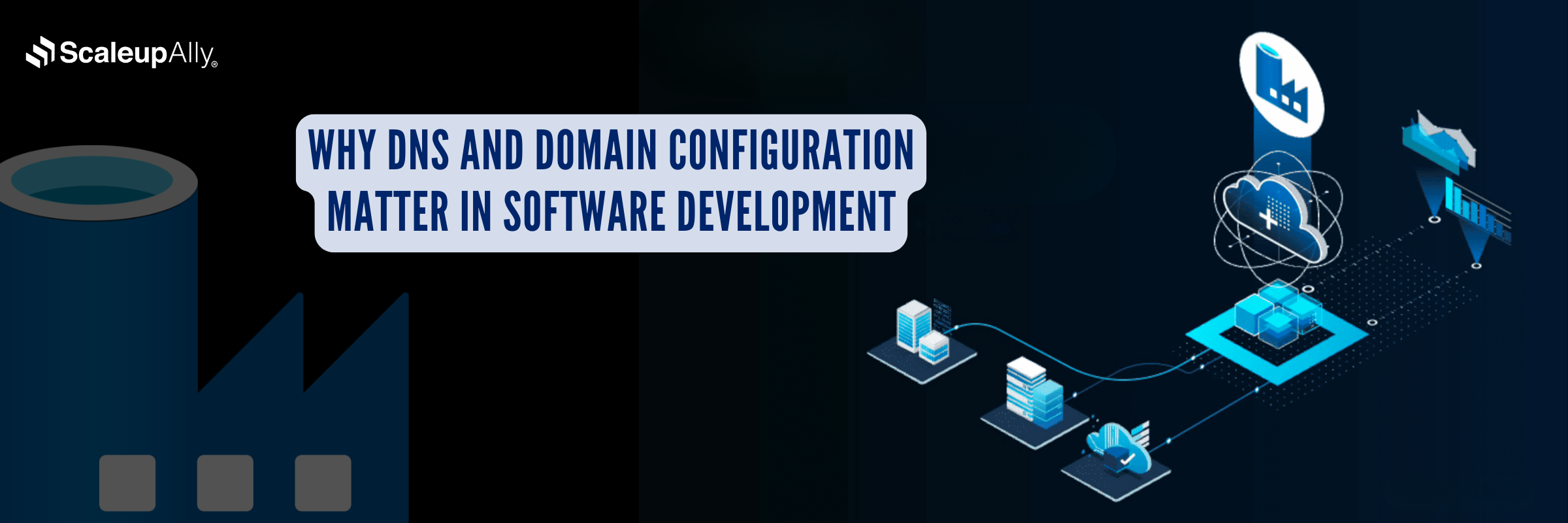
Why DNS and Domain Configuration Matter in Software Development?
Suprabhat Sen | February 18, 2024 , 8 min read
Table Of Content
DNS and domain configuration are essential for running a website/application on the internet. Without DNS, a website cannot be loaded or used. That is a very simple and straightforward way to put it.
If you’re in the field of software development, you may be hearing these words, and you could be confused as to what they mean and their bearing on your work.
In this post, we’ll clear up the confusion and tell you all about DNS, domain configuration, and its importance in software development
Key Takeaways
-
DNS Basics: Translates domain names to IP addresses, enabling website access. Key records include A, MX, NS, CNAME, and TXT.
-
Domain Configuration: Manages settings like DNS records to ensure functionality and integration.
-
Website Access: DNS resolves domain names, making websites reachable online.
-
Email Functionality: Records like MX, SPF, and DKIM ensure email delivery and security.
-
Platform Integration: TXT records verify domain ownership for services like Google Search Console.
-
Proper Setup: Correct DNS configuration ensures smooth operations; tools like DNS lookups help verify settings.
What is DNS?
To get started, let’s first talk about DNS and what it means.
DNS stands for Domain Name System. In the simplest of terms, DNS is the system that changes a human-readable domain name to an IP address. This IP address is then used to fetch and load the domain from the internet.
Without DNS, there would be no way of changing the domain names to their respective IP addresses.
This is one of the most common tasks that DNS performs. However, there are many other things that it is used for as well.
With DNS, you can enter various types of DNS records into the DNS zone of a domain. A specialized it services company can design this zone, document it, and set up change controls to avoid downtime. The A record, for example, is the one that serves the purpose of fetching the IP address for a domain name. The AAAA record, on the other hand, fetches the IPv6 address for a domain name.
In the same way, some records describe the nameserver behind the domain. Others describe the email servers responsible for the domain.
A brief explanation of the different DNS records and their functions
To better understand what DNS is and its functions, here is a brief list of the various DNS records, along with their respective tasks.
- A record: Provides the IPv4 address of the entered domain name.
- MX record: Indicates the mail servers responsible for receiving email on behalf of the domain.
- NS record: Describes the authoritative nameserver for the domain.
- CNAME record: This record is used to map an alias domain name to the canonical (actual) domain.
- TXT record: Used to contain information for the domain in a standard TXT format
What is the meaning of domain configuration?
Domain configuration is a general term that refers to configuring or setting up the various settings of the domain. For example, adjusting the DNS records or making alterations to the availability of the domain would fall under domain configuration.
What is the importance of DNS/domain configuration in software development?
Software development refers to creating and maintaining software and apps of all types. Sometimes, a developed software may only run locally on a single device or a few.
In these situations, DNS and domain configuration don’t apply to said software. The relationship and connection between DNS/domain configuration and software is established once the latter is taken online. In that situation, the domain becomes the digital home of the software, where it can be accessed by other users.
With that said, let’s move on to the points elaborating on the importance of DNS in software development.
1. Making domains accessible and reachable
One of the main things that DNS is essential for is making the domain accessible and reachable in the first place.
Domains on the internet are reached via their IP address. The client queries the web servers for the IP address to load the domain. However, before that happens, the domain name must be converted to the IP address to be looked up.
For example, the domain name “sample.com” has to be converted to its respective IP address before the latter is located and retrieved, causing “sample.com” to be loaded.
This conversion occurs through DNS. Hence, without it, anyone could not reach or access the domain.
2. Ensuring email deliverability
Moving on, another reason that DNS is important for software development is because it helps ensure email deliverability.
When a user on the internet wishes to send an email to a domain, let’s say [email protected], the email client of the sender first has to determine the email servers that the recipient relies on to receive its messages. Once that is determined, the client can send the messages to the receiving server, which can then forward the messages to the particular domain.
For this purpose, MX records are used. MX records are added to the domain’s DNS zone, indicating which server the incoming emails must be routed to.
In terms of software development, the importance of receiving emails is quite significant. SaaS (software as a service) platforms have to receive emails regularly, whether from users or other services they’re using. Without DNS and domain configuration, this wouldn’t be possible.
3. Ensuring safety in email communication
Receiving emails is important, but ensuring safety in the email communication process is even more so. With DNS, you can ensure that the emails being sent to your domain and those sent from it stay safe from any type of malicious tampering.
How exactly does that happen? That happens with the help of protocols such as DMARC. DMARC is a protocol that utilizes various DNS records, such as DKIM and SPF, to ensure the emails stay safe.
With the SPF record, for example, the domain can specify the IP addresses and domains that are cleared to send emails on its behalf. The receiving server can check the domain’s SPF record to ascertain whether the message is actually from it.
The DKIM record, on the other hand, is used for a verification process. The record contains a public key used by the receiving server to check the digital signature on the email message.
4. Creating integrations with other online platforms and services
This is yet another reason why DNS and domain configuration is important in software development. With DNS records, you can integrate your website or your software with other online platforms and services.
Here is how it works.
There are different online services and platforms that require domain owners to establish their ownership before they (the services/platforms) can be integrated with the domain. A very common example of this is in platforms like Google Search Console. Before they connect with your domain, you have to enter a record in the DNS zone. That way, your ownership and access to the domain is established.
For this purpose, the TXT record format is typically used.
How to ensure that DNS records are properly configured during software development?
When building a website using a hosting platform or a CMS, you will find that many of the important DNS records are already configured. For example, if you buy the domain and hosting from an online platform like Namecheap, the A records and the MX records will automatically be setup.
If you wish to do everything on your own, i.e., using your own servers and control panel, etc., then the records may need to be set up from scratch.
However, whatever the situation may be, it is important for you to check and confirm if the DNS records are properly configured. To do that, you can perform a DNS record lookup. When you perform a DNS lookup, all the DNS records for the provided domain will be listed along with a status showing if they are correctly configured.
Final thoughts
And there you have it.
DNS is an important aspect of running and managing websites, whether the latter happens to be a simple blog/landing page or a SaaS platform. In the field of software development, DNS and domain configuration are important as they help in making sure that the domain remains up and running.
Related Blogs

Top 20 Emerging Technologies of 2026
Discover the top 20 emerging technologies of 2026. Explore which innovations are driving change across healthcare, finance, manufacturing, and other crucial industries.
ScaleupAlly Team
Dec 16 ,
9 min read

Online Shopping App Development Cost in UAE | Pricing & Factors Explained
Understand UAE online shopping app development costs in 2025 with pricing ranges, influencing factors, hidden fees, timeframes, and expert savings tips.
Suprabhat Sen
Nov 29 ,
13 min read

Software Development Timeline: Phases, Duration & Estimation Guide
Understand the software development timeline with phase durations, key factors, hidden delays, and practical methods to estimate project time.
Suprabhat Sen
Nov 29 ,
16 min read


